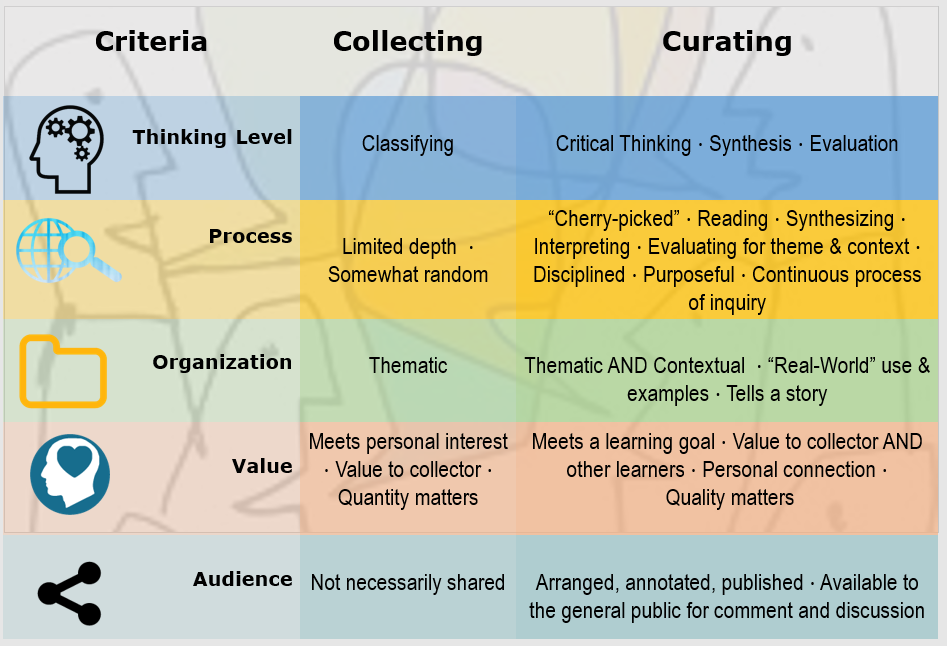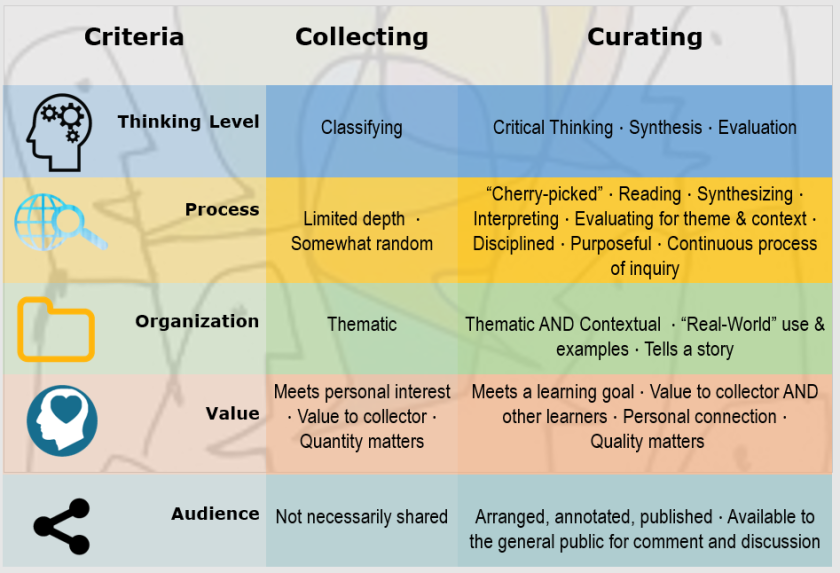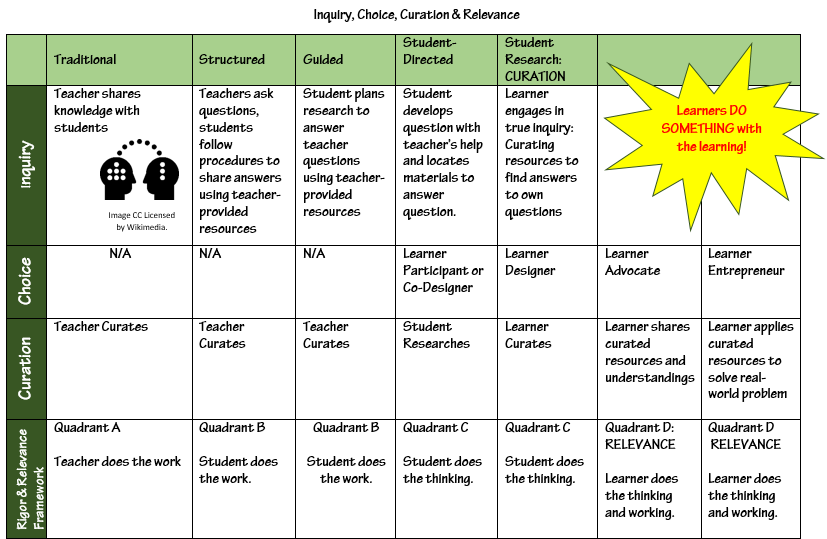During the past 2 weeks, I had the pleasure of working with longtime friend and 8th grade social studies teacher extraordinaire, Terri Inloes, to transform her students into curators of information as they learned about the Social Reform movements of the late 19th century in the U.S. My head is still spinning from the many successes and highlights from this unit – and the powerful learning that occurred! Here are some of the highlights, examples of student work, and some amazing feedback from the students. I am convinced that this is a strategy that not only helps to develop 21st century skills and address Common Core research standards; it also is a strategy that leads to personalized learning and motivates students to learn.
Day 1: The QFT
By the time students get to middle school, it is rare to hear them ask questions – other than to get clarification on what needs to be done for the assignment. The good news is there is a great strategy to help get them back in touch with their own sense of wonder and curiosity –the Question Formulation Technique –or the QFT, which was designed by The Right Question Institute. Terri prepared pairs of photographs representing each of the reform movements, one picture dating back to the late 19th century, and another representing where that social reform movement stands in today’s society. After checking out all of the photos, students settled on the pair of pictures that most caught their interest. They brainstormed and refined questions, and then shared their thinking with the class. This was how they selected the topic which they would curate.
Day 2: Defining Curation; Creating a Research Plan
 Everything happens for a reason, right? Originally, students were scheduled to be in the computer lab and begin setting up their curation tool –Wordpress blogs– on day 2. As it happened, a snow day in the previous week caused the lab to be double-booked, and so we had to come up with a plan B. In retrospect, not going straight to the computers that day ended up being one of the best things that could have happened. We spent this class period helping students to truly understand the difference between “collecting” and “curating” through a beautiful poem, The Curator, by Miller Williams. You could have heard a pin drop as Terri read this to her students. You will see the big ideas they gained from this poem show up again and again in their reflections and responses to the survey we had them fill out after the project. The other good thing we accomplished this day was insisting the students plan their research strategies. We copied 5 different graphic organizers from the book Q Tasks, by Carol Koechlin and Sandi Zwaan, and students were allowed to choose the one that they thought would help them the most in planning their keyword search strategies.
Everything happens for a reason, right? Originally, students were scheduled to be in the computer lab and begin setting up their curation tool –Wordpress blogs– on day 2. As it happened, a snow day in the previous week caused the lab to be double-booked, and so we had to come up with a plan B. In retrospect, not going straight to the computers that day ended up being one of the best things that could have happened. We spent this class period helping students to truly understand the difference between “collecting” and “curating” through a beautiful poem, The Curator, by Miller Williams. You could have heard a pin drop as Terri read this to her students. You will see the big ideas they gained from this poem show up again and again in their reflections and responses to the survey we had them fill out after the project. The other good thing we accomplished this day was insisting the students plan their research strategies. We copied 5 different graphic organizers from the book Q Tasks, by Carol Koechlin and Sandi Zwaan, and students were allowed to choose the one that they thought would help them the most in planning their keyword search strategies.
Day 3: Setting up a WordPress Blog
Our school district has our own domain and server set up for WordPress blogs, and this is integrated with Active Directory, so every single teacher and student in the district already has an account set up there. This made “D20 Blogs” the best choice for the tool to be used for the student curation projects. With about 57 minutes per class period, we were able to show students the basics of WordPress, and encouraged them to work on more sophisticated design features (if they wanted to) from home. Most of the kids worked in collaborative groups. By the end of the day, 130 students had created 70 different blogs and published their first post describing why they chose their topic for this project. The technology worked beautifully!
 Days 4- 8 Curating
Days 4- 8 Curating
I was not able to spend as much time during the curating days with the students, but I kept up with reading their curation blogs as best I could. Terri is the real hero here – commenting on every student’s blog every single night!! She also kept me up –to-date on all of the cool stuff happening during her classes.
From Terri:
Things are really crystallizing for kids. As I’m making comments to kids I’m noticing them commenting to one another with new questions! Kids are totally engaged, you can hear a pin drop in the computer lab.
This is my favorite story:
The class is completely quiet. Riley says, “Mrs. Inloes, I’m also doing research on mental health care because it is in a lot of my research on prison reform.”
Jacob replies, “That’s what’s happening to me, I’m doing prohibition and I’m finding the women’s rights movement.”
“Well, I’m doing women’s rights and now I’m doing almost all the reform movements,” says Paige.
Pretty soon the whole class is piping up with the connections they are making. I didn’t say a word!
Reflection and Feedback
Terri and I were ecstatic reading the reflections and comments from the kids at the end of the project These kids did an amazing job, and the learning went deep. Here are some of my favorite student quotes –reflections on the project, as well as what their understanding is of a curator.
 Students Describe their Understanding of Curating:
Students Describe their Understanding of Curating:
“A curator paints with words. They describe what they are talking about so well that it doesn’t even have to be there for you to see it.”
“With curating, you are using heart. You use emotion and find passion to do that certain job or write about that certain topic.”
“A curator is someone who puts back the history into something and tries to find the story or background from where or what it is truly from.”
“A curator is someone who goes into the details of something to find its back story.”
“With curating, you become engrossed in your topic. You know anything and everything about it. You can talk about it with personality and passion.”
“The difference between curating and collecting research to me is that when you curate research, you have the passion to learn.”
Students Reflect on the Curation Project:
“Curating this project really got me thinking and allowed me to give my own opinion while staying on topic and informing others.”
“It taught me to take research, analyze, and organize it. I liked it because I had to collaborate and come to an agreement on what to post.”
I liked learning new things that I had no idea about before. I liked showing off my talent and curating what I knew.”
“The only thing I would have liked to do differently would be given more time to learn even more about the topics.”
“A project doesn’t have to be stale and boring. It can be fun. You can really care about what you are writing.”
“This project has given me a new respect for bloggers who curate their research because it is hard.”
“My thinking on learning has changed a bit. I suddenly feel like learning isn’t a chore, it’s an opportunity that can open so many doors!”
One of the questions we asked the students is how many would continue their research. Over 1/3 of them said that they would! Want to see more? Here are three student curation blogs:
Equality and Inequality Rights; Then & Now
Mental Health Treatments Past to Present
Prohibition Acts Project



 In the summer of 2012, I began an
In the summer of 2012, I began an 

 Personal Connection
Personal Connection Sharing, Audience – Comments & Discussion
Sharing, Audience – Comments & Discussion Storytelling
Storytelling






